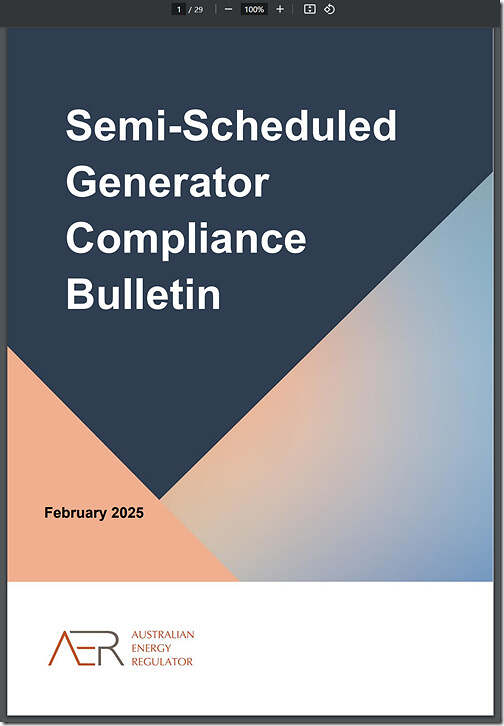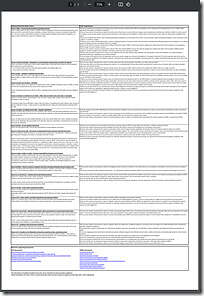We’ve not had a chance to post about this until now, but still very important to our readers (a fair number of them are stakeholders in Semi-Scheduled generators) that just over two weeks ago (on Tuesday 4th February 2025) the AER published an updated Semi-Scheduled Generator Compliance Bulletin and Checklist, as follows:
| The Compliance Bulletin | Other Materials |
|---|---|
|
You can download the 29-page PDF of the Bulletin here:
|
There’s more information on this section within the AER website. That page includes the note: ‘Participants should review their practices in light of the information set out in the bulletin and checklist, and update them as appropriate.’ … and also notes that the update (from the prior bulletin released in August 2022) is updated with respect to three specific changes … Change 1) ‘… the enablement of bid Max Avail for SSGs.’ and also … Change 2) ‘AER’s expectations around the use of self-forecasting by SSGs.’ and also … Change 3) ‘Other minor updates were made in line with amendments to the NER. ’ … note that there may have been more changes, just not called out on the ‘home’ page. Importantly, that page also provides access to this (updated) Compliance Checklist: … which contains many useful links to other detail.
|
With respect to this release from the AER, readers might like to note the following:
(A) What AER notes about the bulletin
There’s a Media Release titled ‘AER updates SSG Compliance Bulletin following enablement of Max Avail’ – (notwithstanding that the enablement of MaxAvail occurred on Monday 7th August 2023, so almost exactly 18 months earlier) in which the AER notes:
‘The AER’s SSG Compliance Bulletin outlines our expectations for SSG compliance with critical obligations under the National Electricity Rules (NER). While these expectations are similar to those for Scheduled Generators, there are some differences due to the reliance of SSGs on specific weather conditions as a fuel source.
The related checklist sets out tasks that may assist SSGs to achieve compliance with the relevant obligations and provides links to relevant supporting procedures published by the AER and AEMO. It also contains web links to related procedures and guidelines.
The SSG Compliance Bulletin has also been updated to reflect the AER’s expectations around the use of self-forecasting by SSGs that choose to submit self-forecasts to AEMO for use in the dispatch process. Other minor updates have been made in line with amendments to the NER.
Participants should review their practices against the information set out in the Bulletin and checklist and update them as appropriate.’
I’ve added highlighting on a couple things that particularly stood out for me.
(B) Specific comments about the changes
With respect to the changes called out by the AER, note the following:
Change 1 = 18 months after the enablement of MaxAvail in the bids of Semi-Scheduled units
We’ve already written many articles pertaining to this change, and collated them here in this category on WattClarity, and there will be more to come. Specific readers might like to note that:
(a) There are earlier articles (well before AEMO’s change) calling for such an implementation.
… Marcelle’s article from December 2020 is a good one for explaining some of the reasoning
(b) There are some articles about the mechanics of the change
i. Linton’s article ‘What inputs and processes determine a semi-scheduled unit’s availability’ from August 2023 is still quite frequently read
ii. and (for those who are licensed users of our ez2view software), remember we upgraded the ‘Unit Dashboard’ widget in conjunction with these changes such that you can see the source of the availability used as an input into NEMDE in truncating the ‘raw’ bid volumes.
c) We have also started to collate data on the outcomes of the change
i. about a year ago, following release of the GSD2023, we published ‘How many Semi-Scheduled units have taken advantage of the market change that went live on 7th Aug 2023?’
… albeit that was only with ~5 month worth of data to look at.
ii. now that we’ve recently released the GSD2024, one of the things we’ll look to do is update that article.
Change 2 = Expectations with respect to self-forecasts
It’s worth readers understanding two things here:
(a) On this page in the Wattclarity Glossary we’ve compiled a range of information about self-forecasting.
… including its history, and its purpose
(b) In addition (and as noted in this review of our 25th year of service in the NEM) we invested in a start-up self-forecasting company a little over 12 months ago
i. Which has heightened (even more!) our interest in self-forecasting and Semi-Scheduled units; and
ii. Already that company has achieved some pleasing successes.
It’s also worth noting that:
(a) The AER’s updated compliance bulletin comes exactly two months after Linton wrote about how ‘AER sends clear message on self-forecasting behaviours’ in an AEMO Intermittent Generator Forum.
… so it’s not like the AER’s update in February can be called ‘out of the blue’.
(b) coupled with this, as time permits in the coming weeks we’ll be collating a series of articles about ‘games that self-forecasters can play’ (already there are some articles tagged like that).
Change 3 = About the NER, and ammendments
More to come, time permitting…
(C) Other commentary about this update from the AER
Where we notice it (and where we have time, and think it will be useful to our readers) we’ll add in links to external commentary here.
But, if particular readers spot something they think would be useful, please feel free to link to it in the comments below?




Be the first to comment on "AER published ‘Semi-Scheduled Generator Compliance Bulletin’ on Tuesday 4th February 2025"